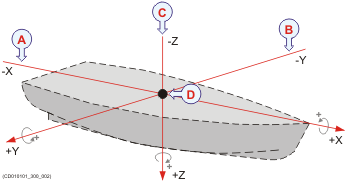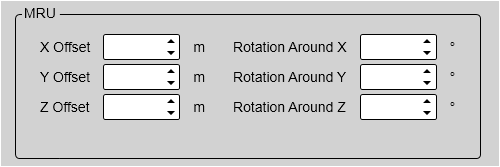MRU (Motion Reference Unit) page
Use the MRU (Motion Reference Unit) page to insert the physical location and rotation of the motion reference sensor (MRU) with reference to the vessel coordinate system.
Description
The ST90 system is provided with a built-in motion sensor to provide electronic stabilization of the sonar beams. It is placed inside the Motor Control Unit. The motion sensor measures the roll and pitch movements of the vessel.
If you want to use the built-in motion sensor, you do not need to enter any offset values.
If the hull unit has been installed with the Motor Control Unit pointing straight aft, you do not need to enter any rotation values. If the unit faces in any other direction you must compensate for this by typing the relevant value for Rotation Around Z.
For improved operational accuracy, an external motion reference unit (MRU) can be used.
- Offsets
The offset values specify the physical location of the motion reference unit relative to the reference point (origin). The relevant offset values can normally be taken from the vessel drawings.
- Rotation
The values for rotation around the X, Y and Z axis are used to compensate for any misalignments made during the physical installation of the motion reference unit. Such misalignments occur if the sensor is not placed in parallel with the vessel’s horizontal and/or vertical planes. We strongly recommend that you install your motion reference unit so that all rotation angles can be set to 0 (zero).
The required accuracy of the offset and rotation angles depends on the accuracy requirements for the echo data.
Correct values for motion sensor rotation are critical for the sonar performance.
The motion sensor offset values (its physical location relative to the vessels' coordinate system) are not important for sonar operation.
The Kongsberg Seapath® - and other GPS systems - allow you to define the MRU location in the positioning system. If this is done, the MRU offset values in the ST90 system must be set to 0 (zero) to avoid "dual compensation". The rotation angles are normally not recorded by the positioning system. These can either be inserted into the MRU control application, or into the ST90 system. Make sure that you do not insert them both places.

- Rotation around the x-axis: In the positive horizontal direction (forward), a positive rotation is clockwise.
- Rotation around the y-axis: In the positive horizontal direction (starboard), a positive rotation is clockwise.
- Rotation around the z-axis: In the positive vertical direction (down), a positive rotation is clockwise.
- Reference point (Ship Origin)

Details
- X Offset
Select the offset value on the X axis (fore-and-aft direction) from the Ship Origin. Adjust with a positive value for X if the sensor is located ahead of the ship origin.
- Y Offset
Select the offset value on the Y axis (athwartship) from the Ship Origin. Adjust with a positive value for Y if the sensor is located on the starboard side of the ship origin.
- Z Offset
Select the offset value on the Z axis (vertical) from the Ship Origin. Adjust with a positive value for Z if the sensor is located under the ship origin.
- Rotation Around X
Specify an angle (in degrees) to compensate for any deviation from the X axis (fore-and-aft direction) in the vessel coordinate system.
- Rotation Around Y
Specify an angle (in degrees) to compensate for any deviation from the Y axis (athwartship direction) in the vessel coordinate system.
- Rotation Around Z
Specify an angle (in degrees) to compensate for any deviation from the Z axis (vertical direction) in the vessel coordinate system.
